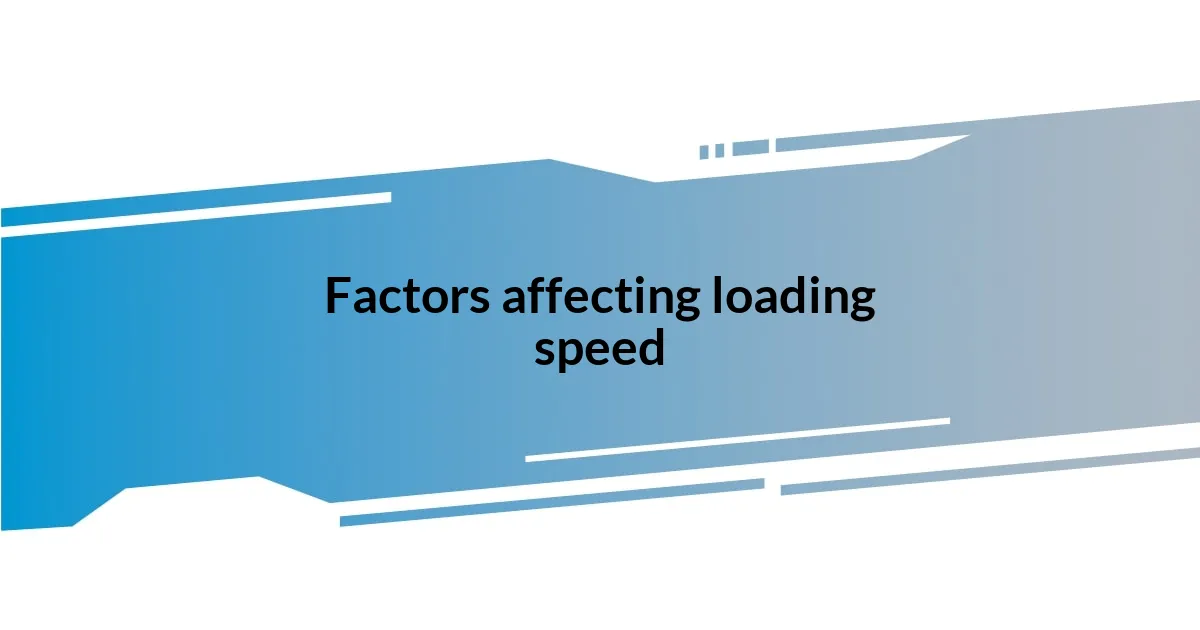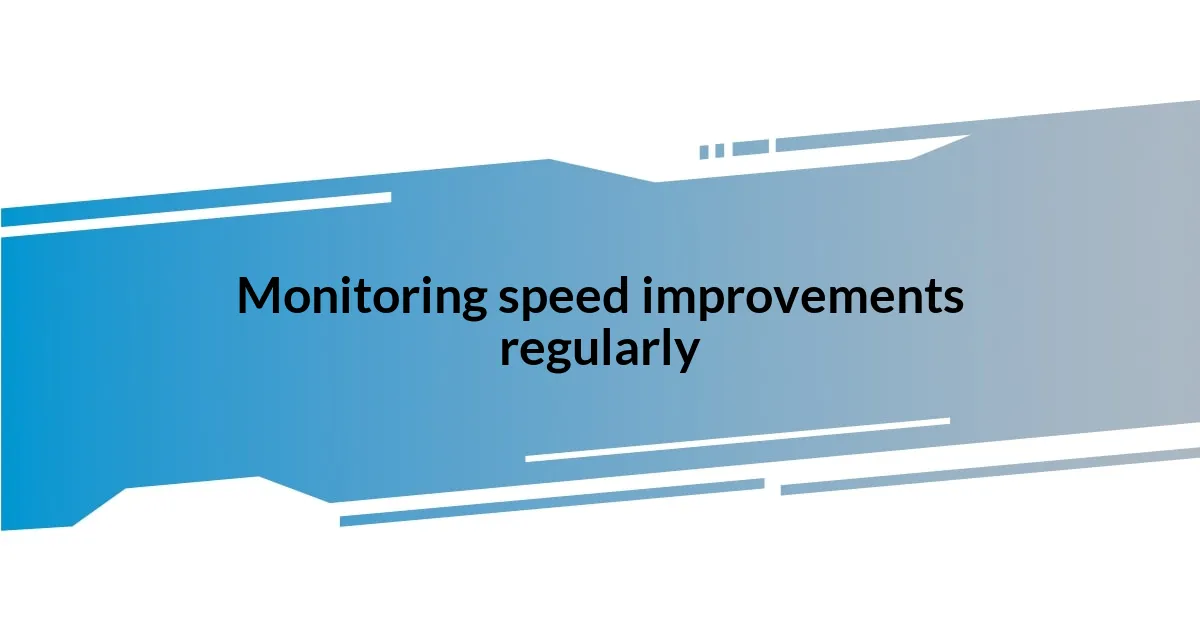Key takeaways:
- Website loading speed is crucial for user experience and impacts conversion rates and search engine rankings.
- Key factors affecting loading speed include image size, server response time, code quality, and the use of external scripts.
- Using performance testing tools like Google PageSpeed Insights and GTmetrix helps identify optimization opportunities and monitor improvements.
- Regular monitoring and adjustments lead to continuous enhancements in loading speed and user satisfaction.

Understanding website loading speed
Website loading speed is crucial for user experience and overall performance. I remember launching a site and watching potential visitors drop off due to slow loading times; it was disheartening. Have you ever abandoned a page just because it took too long to load? This kind of experience underscores why understanding and optimizing loading speed is essential.
Every second counts when it comes to loading speed. Research shows that even a one-second delay can lead to a significant drop in conversions. When I first grasped this, I realized how precious each moment is for retaining visitors. Have you ever considered how speed impacts your audience’s perception of your brand?
Moreover, website loading speed affects your search engine ranking. I once faced the frustrating realization that a sluggish site could hurt my visibility on Google. This revelation motivated me to prioritize optimization. It’s interesting to think about how a few tweaks can make such a difference—what strategies have you considered for improving your web performance?

Factors affecting loading speed
When I dived into optimizing my website’s loading speed, I was surprised by how many different factors played a role in performance. It’s like a web of interconnected elements that all need to be in sync. From the size of the images I used to the quality of my hosting service, every little detail seemed to impact how quickly my site loaded.
Here are some key factors that can affect loading speed:
– Image Size: Large images can increase load times, but optimization tools can compress them without losing quality.
– Browser Cache: When returning visitors access your site, cached files can make it load faster.
– Server Response Time: The time it takes for the server to respond to user requests greatly influences loading speed.
– Code Quality: Clean, efficient coding practices reduce unnecessary weight on your website.
– External Scripts: Third-party services, like ads or social media widgets, can slow down performance if not managed properly.
Once I took a deeper look into these elements, I realized that even small changes could lead to significant improvements. For instance, switching to a faster hosting provider was a game changer for my site’s responsiveness. It felt like I had lifted a weight off my site’s shoulders!

Using performance testing tools
Using performance testing tools has been one of my favorite strategies for analyzing and enhancing website loading speed. I started with basic tools like Google PageSpeed Insights, which provided me with an easy-to-understand score and actionable suggestions. It was eye-opening to see how specific changes, like optimizing images or minifying CSS, could directly improve my site’s performance.
As I explored more advanced tools, I discovered GTmetrix and WebPageTest. They allowed me to test my site from various locations, giving me insight into how real users experienced loading times. I remember experimenting with these tools late one night, eagerly refreshing results as I implemented the suggested optimizations. The thrill of watching my loading times decrease was rewarding, almost like watching a race where my website crossed the finish line faster every time.
In my experience, performance testing tools do more than provide numbers; they tell a story about user experience. For instance, I learned through these tools that my mobile site had a slower load time despite being fast on desktop. This revelation pushed me to focus on responsive design, ensuring that everyone, regardless of device, enjoyed a fast-loading site. Ultimately, using these tools allows me to continually monitor, adapt, and maintain optimal speed.
| Tool | Features |
|---|---|
| Google PageSpeed Insights | Basic scoring, actionable suggestions |
| GTmetrix | In-depth analysis, location-based testing |
| WebPageTest | Customizable testing, waterfall charts |

Optimizing images for faster load
When I first started optimizing my images, I was amazed at how much excess weight they carried. I never realized that even the smallest adjustments could yield significant speed improvements. By compressing images using tools like TinyPNG and ImageOptim, I noticed my site felt lighter and more agile. It was like clearing clutter from a busy room; suddenly everything flowed better.
One discovery that really struck me was the importance of choosing the right file format. I used to think that JPEGs were the way to go for everything, but I learned that PNGs can offer transparency advantages without sacrificing too much quality. This change not only enhanced my images but also ensured they loaded faster. Have you ever experienced that frustrating moment when a page drags because it’s laden with heavy visuals? Now, I can’t help but feel a sense of accomplishment every time I see my images load smoothly.
Additionally, I started experimenting with responsive images through the srcset attribute. This allowed my site to serve smaller images to mobile users, while still delivering high-quality versions on larger screens. The first time I tested this change, I could almost hear the collective sigh of relief from my visitors as they enjoyed faster loading times. It taught me that optimizing isn’t just about speed—it’s about creating a better experience for everyone. Isn’t it rewarding when your hard work translates into a seamless experience for your audience?

Minifying CSS and JavaScript files
I discovered early on that minifying CSS and JavaScript files could dramatically reduce load times. At first, I was skeptical—how could removing whitespace and comments make such a difference? But after using tools like UglifyJS for JavaScript and CSSNano for CSS, I was shocked to see the size of my files shrink considerably. It felt like clearing out decades of dust from an attic; suddenly, my website felt lighter and much brisker.
One experience that stands out was when I integrated minification into my deployment process. I remember the rush of excitement I felt as I pushed my updates and immediately noticed the loading speed improve. It was almost like a magic trick—turning something bulky into a sleek, streamlined version of itself. I can’t help but ask, have you ever experienced the joy of instantaneous gratification from a tech tweak? It’s exhilarating!
Since then, minification has become part of my optimization toolkit, and I’ve realized that even small changes add up to big results. With faster loading times, my bounce rate dropped as visitors began staying longer to explore my content. This transformation made me appreciate the importance of fine-tuning my site and the direct impact it had on user engagement. Isn’t it incredible how those little adjustments in code can lead to a vastly improved user experience?

Implementing caching strategies
Implementing caching strategies transformed my website’s performance in a way I hadn’t anticipated. Initially, the concept of caching felt a bit abstract to me—how could storing data temporarily have such a beneficial impact? However, after enabling browser caching and server-side caching methods like Varnish, I soon realized the magic of quick access to frequently used resources. It was like finally giving my visitors a shortcut to their favorite spots instead of making them wander around.
One of my favorite experiences was when I set up a Content Delivery Network (CDN) to complement my caching efforts. The first time I tested it, I noticed a considerable reduction in loading times, especially for users across the globe. It felt exhilarating to think that someone thousands of miles away could access my site in a flash, without the usual latency. Have you ever thought about how much ease this brings to a user’s experience? The immediate access was a game-changer, and I could practically hear users celebrating in the background.
Emphasizing caching not only improved my website speed but also enhanced my site’s reliability. There was a moment, during a particularly high-traffic event, when I braced myself for slowdowns or crashes. Instead, thanks to my caching setup, everything ran smoothly, and my confidence soared. I wondered, how often do we overlook these behind-the-scenes solutions that can make such a big difference? It underscores the importance of caching as a cornerstone of web optimization—one that ensures a seamless experience for every visitor.

Monitoring speed improvements regularly
Monitoring website speed improvements is a crucial part of my optimization journey. I make it a habit to regularly check my site’s performance using tools like Google PageSpeed Insights and GTmetrix. Every time I see a score shift, it’s like opening a surprise gift; I revel in the excitement of witnessing my hard work translate into faster load times. Have you ever felt that surge of satisfaction when numbers move in your favor?
I remember a specific instance when I noticed a significant spike in loading speed after implementing new optimization techniques. I was thrilled to track that progress over the weeks, observing how consistent updates led to continuous improvements. Regular monitoring not only reassured me about my efforts but also highlighted areas still needing attention. It’s a bit like gardening; you tend to your plants and notice how they flourish with time, but you have to keep an eye out for weeds!
Keeping track of these speed changes has reinforced the understanding that optimization is an evolving process. I often find myself diving into the analytics, eager to uncover patterns and insights. It’s fascinating to see what adjustments yield the best outcomes. Have you ever thought about how important it is to celebrate those incremental victories? Each small improvement adds up, creating a culture of continual growth and refinement in my website’s performance.